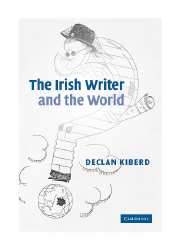Book contents
- Frontmatter
- Contents
- Acknowledgements
- A note on the text
- 1 Introduction
- 2 The fall of the Stage Irishman (1979)
- 3 Storytelling: the Gaelic tradition (1978)
- 4 Writers in quarantine? The case for Irish Studies (1979)
- 5 Synge, Yeats and bardic poetry (2002)
- 6 George Moore's Gaelic lawn party (1979)
- 7 The flowering tree: modern poetry in Irish (1989)
- 8 On national culture (2001)
- 9 White skins, black masks: Celticism and Négritude (1996)
- 10 From nationalism to liberation (1997)
- 11 The war against the past (1988)
- 12 The Elephant of Revolutionary Forgetfulness (1991)
- 13 Reinventing England (1999)
- 14 Museums and learning (2003)
- 15 Joyce's Ellmann, Ellmann's Joyce (1999)
- 16 Multiculturalism and artistic freedom: the strange death of Liberal Europe (1993)
- 17 The Celtic Tiger: a cultural history (2003)
- 18 The city in Irish culture (2002)
- 19 Strangers in their own country: multiculturalism in Ireland (2001)
- Index
5 - Synge, Yeats and bardic poetry (2002)
Published online by Cambridge University Press: 22 September 2009
- Frontmatter
- Contents
- Acknowledgements
- A note on the text
- 1 Introduction
- 2 The fall of the Stage Irishman (1979)
- 3 Storytelling: the Gaelic tradition (1978)
- 4 Writers in quarantine? The case for Irish Studies (1979)
- 5 Synge, Yeats and bardic poetry (2002)
- 6 George Moore's Gaelic lawn party (1979)
- 7 The flowering tree: modern poetry in Irish (1989)
- 8 On national culture (2001)
- 9 White skins, black masks: Celticism and Négritude (1996)
- 10 From nationalism to liberation (1997)
- 11 The war against the past (1988)
- 12 The Elephant of Revolutionary Forgetfulness (1991)
- 13 Reinventing England (1999)
- 14 Museums and learning (2003)
- 15 Joyce's Ellmann, Ellmann's Joyce (1999)
- 16 Multiculturalism and artistic freedom: the strange death of Liberal Europe (1993)
- 17 The Celtic Tiger: a cultural history (2003)
- 18 The city in Irish culture (2002)
- 19 Strangers in their own country: multiculturalism in Ireland (2001)
- Index
Summary
DYING ACTS
The old order of the filí or Gaelic poets began to disintegrate after 1600, as the English extended their conquests over Ireland. In response, many poets began to proclaim the death of their tradition: but they did so in lines of such vibrancy and power as to throw the thesis into question. They were rather like those soldiers who play dead on a battlefield, the better to rise and fight again. Ever since the early 1600s, the Irish language has contained statements of its imminent doom in every generation, yet four hundred years later it faces into the new millennium still truculently alive.
The best poems of the filí were in fact written after the crisis of 1600 and in direct response to it. ‘Ceist, Cia Cheannóidh Dán?’ (Question, who'll buy a poem?) captures the crisis of men deprived of ancient patronage and forced instead to contemplate the indignities of the open market. Like Baudelaire's flâneur they traverse their society, ostensibly to take a look at it but in reality to find a buyer. As such, these ruined bards provide a spectacularly early case of modernism avant la lettre. Their attempt to fit the old mandarin forms to the needs of a new social order put them in the classic predicament of the dandy – courtiers dispossessed of a court.
- Type
- Chapter
- Information
- The Irish Writer and the World , pp. 70 - 90Publisher: Cambridge University PressPrint publication year: 2005
- 2
- Cited by



